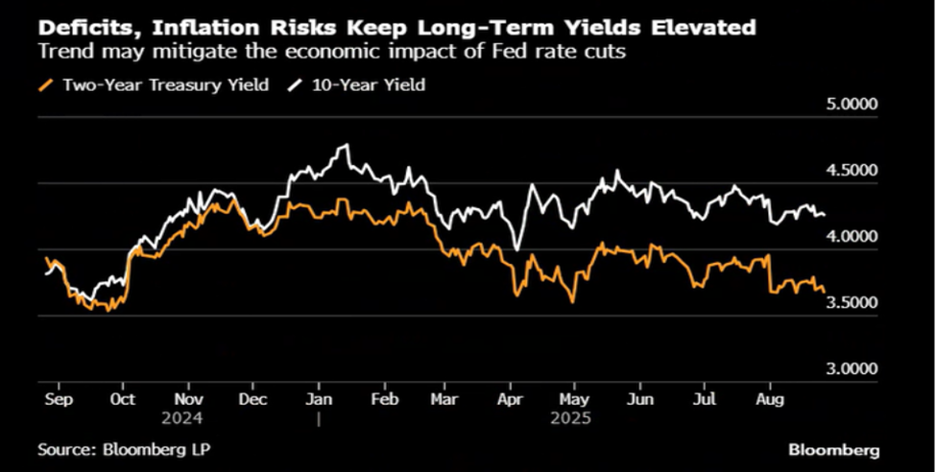As we shift from summer to fall, change is all around. This theme was certainly on Fed Reserve members’ minds at their annual meeting in Jackson Hole. The Fed signaled that they would, in all likelihood, cut interest rates in September after being on pause since December of 2024. The Fed rate has been held at 4.25-4.50% following three rate cuts in 2024. Weakness in the labor market was a concern for the Fed, and they noted “downside risk to the labor market” may warrant a policy change. They also emphasized that inflation remains a top concern, so they may not be willing to cut rates in the future if inflation reaccelerates. We may only see one interest rate cut this year as the Fed tries to balance its dual mandate of ensuring both maximum employment and stable prices.
Curve Shift – Steepening
Expectations of interest rate cuts have pushed the front-end of the curve lower, particularly the 2-year treasury, which is most sensitive to rates changes. It is currently well below 4% and recently hit its lowest level this year at below 3.50%. The 10-year treasury has not seen the same general decline, staying in a trading range between 4.00% and 4.40%. Despite uncertainty regarding tariff-driven inflation, rising debt levels, and future Fed policy, the 10-year yield remains close to where it was on Election Day in November 2024. However, for even longer-term bonds such as 30-year treasuries, yields remaining elevated can be representative of a lack of confidence related to these topics much farther into the future – investors are demanding compensation for these uncertainties. However, a steep yield curve is a positive for equities in the financial sector, as they make profits on these spreads.

We have also seen similar moves in rates overseas. In European G10 countries, most central banks have already cut interest rates, and markets are also pricing in expectations of future cuts where cycles remain in progress. Looking at the spreads between 2-year and 10-year treasuries internationally, we see a positive spread between these two tenors. Furthermore, we see the spread between 2-year securities and 30-year tenor is also positive. This could also be a signal that markets are pricing in economic growth and potentially higher inflation in the future.

Credit Quality Check
It is important for fixed income investors to perform regular “maintenance checks” on their holdings and review the quality metrics of the companies they own. Most bonds carry a credit rating issued by agencies such as S&P or Moody’s – where high-grade ratings range from AAA/BBB to Aaa/Baa. Generally, credit metrics have remained stable in the investment-grade bond market. This year, upgrades have outpaced downgrades from both agencies. If we see an uptick in ratings downgrades or revised negative outlooks, it may signal that we are entering a tougher economic environment, although we believe this to be highly unlikely.

Currently, credit spreads remain at historically low levels. This indicates that investors view the economic backdrop as healthy and that demand for debt remains high. If we see credit spreads widen, it can suggest investors perceive higher default risk, signaling potential economic weakness. We last saw this occur in 2020 during the COVID market meltdown. Again, we think this has a low probability based on health of corporate earnings and balance sheets.
Unlock Value – Bonds May Provide Stability During Equity Market Volatility
Bonds often take a back seat to equities because investors tend to focus on stock market growth. It is important, however, not to overlook the value that bonds can provide. With their semi-annual coupon payments, bonds deliver predicable income even when equity markets are stalled or declining.
Today's rate environment remains favorable, with 4% and 5% coupon bonds available to help keep you on track toward your financial goals. Rates at these levels may soon be in the rear-view mirror if expected interest rate cuts come to fruition or if the economic backdrop changes in a meaningful way. We have already seen rates on short-term fixed instruments decline, forcing investors to reinvest at lower rates. If you have a significant portion of your short-term holdings in money markets instruments, we advise you to contact your Private Client Advisor to discuss possible solutions to lock in higher rates.
We craft our fixed-income portfolios with your journey in mind. We specialize in individual bonds and can tailor corporate, treasury and municipal holdings according to your preferences and after-tax yields. Our strategy focuses on locking in current rates for the future, while mitigating reinvestment risk by building laddered bond portfolios across short, intermediate, and long-term durations.
We hope this Fixed Income Update is helpful, and please feel free to share it with your colleagues, family, and friends.
If you have a friend or family member who would be interested in a no-cost portfolio review, please let us know.
Thank you again for your continued vote of confidence in our work. Wishing you a happy and healthy fall!
Watch

.jpg)